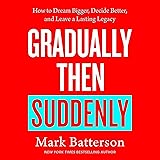A curious phenomenon often arises when individuals embark upon the journey of personal growth: an unwavering belief that more introspection invariably leads to enhanced well-being. This perspective, widely propagated by a multi-billion dollar self-help industry over several decades, suggests that an ever-increasing degree of self-awareness is unequivocally beneficial. However, as insightfully articulated in the accompanying video, this conventional wisdom may overlook a critical nuance. It is being increasingly evidenced that self-awareness, rather than functioning like an unlimited resource such as money, might be more aptly compared to a therapeutic agent or a potent medicine.
While an initial dose of self-awareness is undoubtedly vital for addressing specific psychological ailments, an overabundance of it, particularly in an already stable individual, could inadvertently lead to adverse outcomes. The video delves into this intriguing concept, exploring the intricate dynamics through which self-awareness can both empower and impede an individual’s psychological health. A closer examination of the mechanisms underlying psychological interventions, such as therapy, reveals compelling reasons why this paradoxical relationship with self-awareness merits careful consideration.
Deconstructing Therapeutic Efficacy: Beyond the Modality
The field of psychotherapy has witnessed a proliferation of modalities over the past century, a veritable “alphabet soup” of approaches including Cognitive Behavioral Therapy (CBT), Dialectical Behavior Therapy (DBT), Psychodynamic Therapy, and Humanistic Therapy, among many others. These diverse frameworks are often presented as distinct pathways to psychological healing, each with its own theoretical underpinnings and specific techniques. Despite the vast intellectual investment and clinical application across millions of individuals, a definitive understanding of why therapy functions effectively remains somewhat elusive for psychologists.
Extensive research efforts have been dedicated to discerning which of these numerous therapeutic approaches yield the most superior outcomes. Surprisingly, the collective findings suggest a notable convergence in efficacy across modalities. It has been observed that the specific type of therapy undertaken often contributes less to positive change than the mere engagement in the therapeutic process itself. Furthermore, some studies have indicated that the formal training and credentials of a therapist might possess less measurable impact than previously assumed, with thoughtful amateurs sometimes facilitating similar benefits.
This evidence suggests that the fundamental value derived from therapy may not reside primarily in the intricate theories or specialized techniques employed. Instead, the crucial element appears to be the provision of a safe, non-judgmental context where an individual is regularly afforded the opportunity to articulate and explore their problems with an attentive and empathetic listener. This environment, often described as a ‘holding space,’ allows for the externalization of internal conflicts, thereby initiating a process of critical self-reflection that is instrumental for personal growth.
The Cognitive Mechanics of Healthy Introspection: Disidentification
The profound benefits often associated with practices like journaling and meditation can be understood through a similar lens. These self-directed activities facilitate a crucial psychological process known as disidentification. To elaborate, consider the philosophical framework proposed by Arthur Schopenhauer, who posited a division of consciousness into the subject, or the observer, and the object, which is whatever is being observed. Normally, our ‘I’ functions as the subject, with external phenomena or immediate internal states being the objects of our attention.
When our thoughts, emotions, and impulses are inextricably bundled within the subjective ‘I,’ they are frequently experienced as an inherent part of our identity, rendering critical analysis difficult. For instance, an unexamined feeling of anger might simply be perceived as ‘I am angry,’ with no space for objective appraisal. The act of externalizing these internal experiences, whether through verbal articulation in therapy, written expression in a journal, or detached observation during meditation, transforms them into objects of consciousness. This objectification creates a vital psychological distance, allowing these once-fused elements to be scrutinized with greater objectivity.
Once disidentified, an emotion such as anger can be examined: its origins can be questioned, its utility assessed, and its transient nature recognized. This analytical detachment is fundamental to chipping away at the undifferentiated ‘ego’ and fostering genuine self-awareness. It enables an individual to recognize that while feelings arise, they do not necessarily define one’s entire being. This capacity for disidentification is, in essence, a prerequisite for effectively managing emotional baggage and navigating complex psychological terrains, providing the foundational tools for personal evolution.
The Peril of Excessive Introspection: Pathologizing the Normal
While the cultivation of self-awareness is foundational for personal development, an excessive or misdirected pursuit of it can precipitate counterproductive outcomes. Consider a scenario where an individual, having resolved significant issues through therapeutic engagement, continues to seek out problems to analyze. This sustained search can inadvertently lead to the inflation of minor discomforts into perceived major psychological deficiencies. A subtle feeling of disconnection at a new workplace, for instance, might be disproportionately amplified, prompting a retrospective search for deep-seated childhood traumas to ‘explain’ a normal life challenge.
This phenomenon, where the healthy desire for self-improvement morphs into an obsessive quest for pathology, is particularly concerning. It is in this vulnerable state that the human brain, remarkably adept at pattern recognition and narrative construction, can inadvertently conjure or distort memories to fit an emerging ‘problem.’ Such processes have been scientifically documented and are integral to understanding False Memory Syndrome, a severe issue that came to prominence in the 1970s and 1980s. During this period, certain therapeutic practices were observed to inadvertently incite fabricated memories in patients, often with devastating psychological consequences that required significant recovery efforts from the profession.
The distinction between healthy and unhealthy self-awareness is critical: the former normalizes what might be perceived as pathological, integrating it into a broader understanding of human experience; the latter, conversely, pathologizes what is inherently normal. A growing societal concern is the observed paradox where, despite an unprecedented global awareness of mental health issues, overall mental well-being appears to be declining. This suggests that the increased introspection, rather than leading to robust mental health, may be fostering an environment where normal human experiences of anxiety, sadness, or frustration are erroneously labeled as clinical disorders, thereby potentially inhibiting natural resilience and adaptive coping mechanisms.
Reclaiming Balance: Practical Strategies for a Healthier Self-Awareness
For individuals who perceive themselves or others as being overly self-conscious or excessively focused on internal states, a recalibration of approach is often warranted. Several pragmatic strategies can be employed to foster a more balanced and constructive relationship with self-awareness. The initial step involves reframing the perception of discomfort or challenges; these are not invariably problems requiring an immediate, exhaustive solution. Emotions such as anxiety, anger, or fear frequently serve as natural, adaptive feedback mechanisms, conveying important information about one’s environment or internal state. They are not always indicators of a dysfunction demanding rectification, but rather components of a rich and complex emotional landscape that can be acknowledged without over-analysis.
A fundamental principle is the avoidance of ‘fixing what is not broken.’ If an individual’s life trajectory is generally positive and fulfilling, the active search for hidden pathologies can be detrimental. This proactive problem-seeking often leads to the inflation of minor inconveniences into significant psychological burdens. If external pressures attempt to pathologize normal experiences, a firm assertion of this boundary is often necessary. Furthermore, engaging in regular physical activity is an exceptionally effective antidote to an overactive mind. Physical exertion not only enhances physiological well-being but also provides a potent distraction, redirecting mental energy away from unproductive rumination and fostering a sense of groundedness.
Ultimately, a more liberated approach to certain emotional burdens can be immensely beneficial. If a past event or unresolved issue continues to exert emotional control, a critical evaluation of one’s capacity to alter or influence it is important. If no such control exists, the practice of acceptance and ‘letting go’ becomes a powerful tool for liberation. This strategic detachment is not a form of denial but rather a recognition of psychological agency, allowing energy to be conserved for aspects of life that are within one’s sphere of influence. This perspective fosters a healthier, more adaptive form of self-awareness, steering individuals away from the detrimental effects of excessive introspection and towards genuine well-being.








